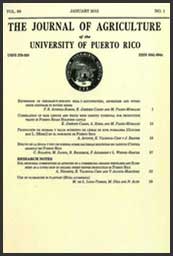Abstract
Entomopathogenic fungi were isolated parasitizing coffee borer beetle (Hypothenemus hampei Ferrari) and banana weevils (Cosmopolites sordidus Germar) in different parts of the island of Puerto Rico to be identified and examined for their pathogenicity on pepper weevil (Anthonomus eugenii Cano). Fungi were isolated and purified in acidulated potato dextroseagar (PDA) in the laboratory of the Plant Disease Clinic at the Agricultural Experiment Station, Juana Díaz. Seven fungal isolates were obtained from the municipality of Comerío, and one from the municipality of Adjuntas. Morphology, DNA sequences of different genetic regions of interest, and microsatellites were used for identification of fungal isolates. Two of the eight isolates were identified as Beauveria bassiana, three as Beauveria caledonica, two as Paecilomyces fumosorosea and one as Paecilomyces lilacinum. Pathogenicity tests were conducted in vitro using conidia suspension (1 x 106 conidia/mL). Insects were inoculated by immersion (10 sec) in the conidia suspension. Daily mortality data was taken (TL50, TL90) and the mean of the treatments were determined. All the fungal species were pathogenic to A. eugenii. The most effective treatments were: P. fumosorosea (Pae1) and B. bassiana (Bb1 & Bb3) with TL50 of 2.39, 2.53 and 2.56 days, respectively, while TL50 for the control was 6.56. A 100% mortality for treatments occurred between the fourth and sixth day compared to control, which reached it in 12 days. These isolates have the potential to be used on an integrated management program for the control of the pepper weevil.

